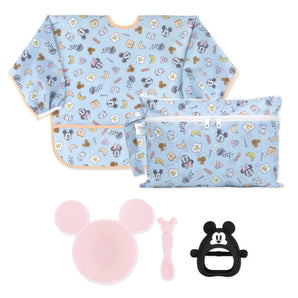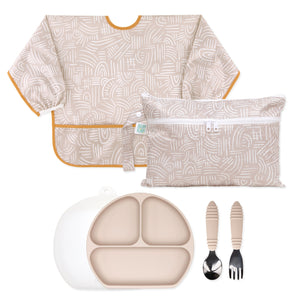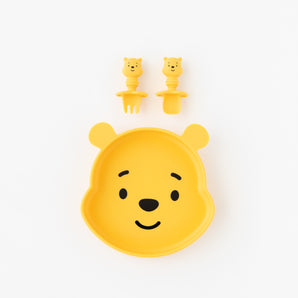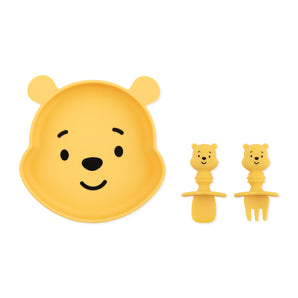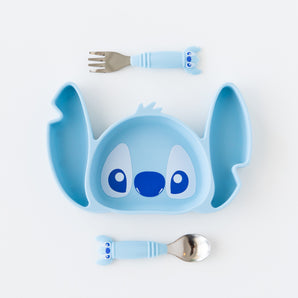Prepare yourself, the teeth are coming in. Often an uncomfortable milestone for all parties involved, teething can be as unpredictable as a chatty toddler in a checkout line. While you can expect a full set of chompers by age three, baby teeth erupt at different times and present with varied symptoms. We put together some helpful tips, tools, and solutions to help prepare you for this temperamental stage in your little’s life.
When Do Babies Start Teething?
It varies, but baby teeth typically first erupt right around the time you’ve managed to get your tot to sleep, between 4-6 months. Some early teethers start at 2-3 months while others won’t get their first tooth until the end of their first year. That said, babies can experience teething symptoms before teeth begin to show. Check out The American Dental Association's eruption chart for more info on teething timelines.
Something to chew on: When it comes to teething, the apple doesn’t fall too far from the tree — many doctors tie teething timelines to family history.
What are the first signs of teething?
Has your little taken a sudden interest in putting anything and everything in his or her mouth? Are they suddenly grumpy, turning down their favorite foods and producing an endless supply of saliva? If you answered yes, chances are high your little drool monster is teething. Here are some other tell-tale signs:
Common Teething Symptoms
- Excessive drooling that can cause a mild skin rash around the chin, neck or chest
- Swollen, tender gums
- Fussiness, irritability, and crying
- Disrupted sleep
- A raised temperature (NOT a fever)
- Biting, chewing, or gnawing on random objects (or mom & dad)
- Cheek rubbing and ear pulling to relieve traveling gum pain
- Turning away solid foods that irritate tender gums
How do you soothe a teething baby?
Teething symptoms usually present a few days before a tooth erupts and continue to reappear as new teeth come in. As many parents know, there is no cure-all for teething infants but there are time-tested options available to treat the symptoms. If you're wondering, how can I soothe a teething baby naturally? Here’s what we suggest:
Give a Gum massage: Massaging or putting pressure on the tender area can help alleviate pain related to gum inflammation. For quick relief, the Mayo Clinic recommends applying gentle pressure on the baby’s sore gums with a clean finger or wet gauze.
Chill it out: Help reduce inflammation by chilling fruit, teethers, or pacifiers. Put them in the fridge over the freezer; too much cold could further irritate gums. Another quick solution — take a small chilled metal spoon and use the back to apply light pressure on the tender area.
Wipe away drool: Keep a clean cloth handy to wipe away drool around the chin, chest, and neck. Keeping the area dry can help prevent a rash often brought on by saliva build-up.
Invest in a safe teether: While the short term solutions above work great, these growing pains continue for up to three years. Many parents prepare by investing in quality teethers or teething rings designed to distract and ease gum pain. Teething toys are also known to support the development of motor skills and help babies learn to self soothe.
All teethers are not created equal
When it comes to teethers, materials matter. As your baby’s teeth begin to show, so does their bite, which means they can break through and ingest teethers made of toxic materials. The FDA banned BPA in baby bottles in 2012, but recent studies determined that many unregulated plastic teethers contain trace amounts of the known endocrine-disruptor. So, what’s in a good teether?
What to look for in a teething toy:
⭐Food-safe, lab-tested materials: Safe options include food-grade silicone, 100% natural rubber or hardwood. We use platinum silicone for its pliability, durability, and safety — It’s bacteria-resistant, gentle for baby and strong enough to provide the pressure needed to relieve gum pain.
⭐Texture: raised designs can help put added pressure on sore gums
⭐Engaging: take the focus off the pain with patterns and colors that engage baby’s senses and imagination.
⭐Easy-to-clean: be sure your teether is easy to clean and safe to boil to avoid bacteria and mold build-up
⭐Fits in baby’s mouth: Make sure the ends or arms of the teether fit in baby’s mouth so he or she can reach molars and sore areas
🚫Avoid: teethers with liquid or gel inside, plastic teethers, teethers that contain PVC, latex, BPA-free plastic, or vinyl

We believe anything you willingly let baby put in their mouth should be held to high standards. That’s why we take pride in our rigorous lab testing process to ensure you have the safest possible products. Our teethers, rings, and charms are made from 100% platinum silicone — BPA-free, PVC-free, cadmium-free, phthalate-free, lead-free, and CPSIA compliant.
And our Bumkins babies love them! Give your little safe relief and something fun to chew on with our quirky line of silicone teething toys!






